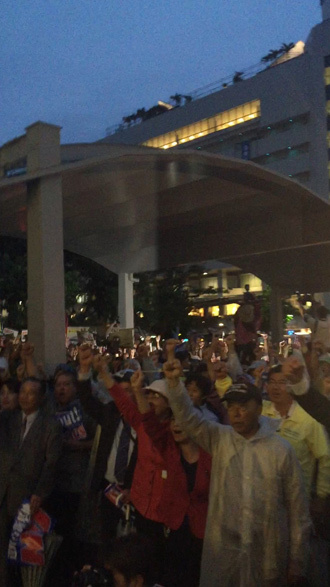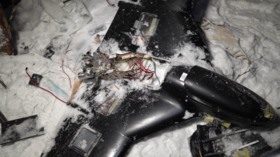‘Don’t rape the sea!’ Hundreds protest US military base relocation plan in Japan

About 300 people protested against the planned relocation of a US military base in Japan’s Okinawa prefecture. The rally fell on the 63rd anniversary of the country’s regaining of sovereignty after its defeat in World War II.
READ MORE: US & Japan unveil new defense policy amid China tensions
The demonstrators gathered on Tuesday, at the gates of the US Marines’ Camp Schwab in the tourist seaside town of Nago, Kyodo news agency reported. The district has been proposed as a relocation site for the US Marine Corps Air Station Futenma.

The the participants of the protest chanted slogans such as “we’re opposed to a new base” and “don’t destroy the beautiful sea.”
Alongside with “peace issues, sovereignty issues and military threat issues”, the base relocation controversy “has a strong environmental component,” Peter Galvin, founder of the US Center for Biological Diversity, told RT.
An “enormous landfill project to the ocean” in order to expand a military base in Henoko is being planned, according to Galvin.
Okinawa is meanwhile home to a population of an endangered species of marine mammals, called the dugong. There are only between 12 to 50 sea-cow like creatures left in the bay site, a fragile ecosystem of a coral reef.
Social Democratic Party chief Tadatomo Yoshida and Okinawa prefectural assembly members were among the protesters who chose to oppose the base relocation plan in boats at sea.
According to the Japan Coast Guard (JCG), four people ended up in the ocean waters, as one of the boats capsized. It was intercepted by a JCG vessel after a breach of a no-entry zone, and one person was hospitalized.
“I am a doctor, I should save life, save nature – that’s my duty. We have been suffering for nearly 70 years,” Toshiro Uehara, native Okinawan and anti-US base protester, told RT. “I believe in the Japanese constitution, article nine. It denies military.”
Susumu Inamine, Nago mayor, recalled the anger of Okinawa residents in 2013, when Tokyo celebrated the date. He also criticized the fact that Prime Minister Shinzo Abe visited the White House on that very day to have talks with US President Barack Obama.

Australian citizen, who has been living in Okinawa for many years, Catherine Jane Fisher from WARriors Japan (Women Against Rape) shared her story with RT. She said she was raped by a US military serviceman, who was later found guilty, but managed to flee from Japan to the US.
“Don’t rape us!” and “Don’t rape the sea!” were the slogans, that united the protesters, according to Fisher.
“Many of the women who have been protesting the last twenty years, who have been sitting outside camps of the military base, have been raped,” Fisher told RT. “I will continue to fight for the Okinawan people against zero tolerance policy, which the United States has so blatantly set for the last 20 years – with continued rapes and murders.”
Okinawa prefecture remained under US control until 1972, when it was returned to Japan. Yet, it was on April 28, 1952, when the San Francisco Peace Treaty ended the postwar occupation of the country, known as a “day of insult” in the southern prefecture.












